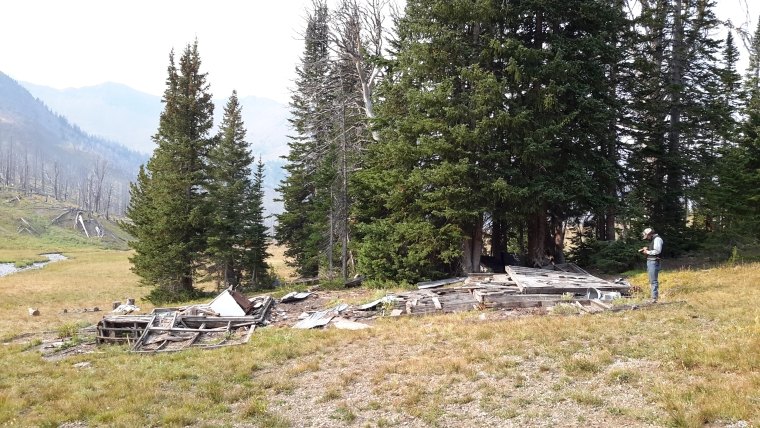As the current administration prioritizes addressing the legacy of unsafe and environmentally harmful abandoned mining sites, mining reclamation projects are on the rise. In this piece, I’ll explore taking an ecological restoration response to reclaiming abandoned mine lands (AML) that supports traditional engineering solutions, integrating nature-based solutions into the world of mining reclamation. While the focus is on abandoned mine lands, we can use the same approaches for the closure of operational mines.
 An archaeologist conducting a cultural resource survey for an abandoned mine reclamation project in the Absaroka Mountain Range in Park County, Wyoming.
An archaeologist conducting a cultural resource survey for an abandoned mine reclamation project in the Absaroka Mountain Range in Park County, Wyoming.ADDRESSING ENVIRONMENTAL CHALLENGES OF ABANDONED MINE LANDS
 Daisys growing on railroad tracks from a Mining permitting project in North Carolina.
Daisys growing on railroad tracks from a Mining permitting project in North Carolina. Undertaking mine reclamation and restoration of abandoned mine lands, especially in the challenging terrains where abandoned mines are typically located, presents many challenges. These challenges stem from environmental, technical, legal, and financial domains, each contributing to the complexity of restoration efforts.
Even decades after mining activities cease, the risks associated with abandoned mines persist as people develop or access these often-remote areas for recreation. Places popular for mine development, such as the western United States or eastern coal mining states, are also often home to diverse ecosystems that are highly sensitive to disturbances. Mine reclamation efforts must carefully balance restoration with the preservation of existing flora and fauna. Many abandoned mines leach heavy metals and produce acid mine drainage, impacting waterways and affecting downstream aquatic life and drinking water quality. The physical disturbances from mining activities often leave landscapes prone to erosion and landslides. Restoring soil stability and fertility is a significant challenge, especially on steep slopes. The high altitude and variable climate of abandoned mine locations can also present challenges by limiting the window for reclamation work and the selection of plant species for revegetation.
ECOLOGICAL RESTORATION METHODS FOR ABANDONED MINE CLOSURE
A major challenge in the rehabilitation of mine land is the re-establishment of self-sustaining vegetative cover. While site stabilization and waste material management through chemical amendments form the basis of reclamation strategies, there is an increasing focus on the replacement of ecosystems representative of the pre-mined state. Ecological restoration techniques are key to supporting this ecosystem development and advancing abandoned mine reclamation.
We can address these environmental challenges in many ways.
Soil Stabilization and Fertility: Restoring soil structure and function is crucial to the long-term resiliency of restoration sites through improved nutrient cycling and water retention. Techniques like bioengineering, which uses plant materials to stabilize soils, and the addition of organic matter to improve fertility, can help prevent erosion and promote the establishment of vegetation. Increased microbial biodiversity results in stable soil aggregation and improved soil structure through the production of substances that bind soil particles.
The use of site-specific amendments to address pH, electrical conductivity, and metal conditions can help improve soil stability. Amendments have included lime, biochar, and compost to manage chemical conditions and nutritional availability, and microbial inoculants to improve soil health, including soil structure, nutrient cycling, and carbon sequestration.
Phytostabilization techniques are used to reduce inputs and associated costs with soil amendments while improving long-term resiliency. Additional techniques employed effectively on these sites include rough and loose soil configurations and the application of large woody debris for species diversity establishment, which also provides simple, inexpensive erosion control. Creating diverse conditions in the physical environment can help produce a diverse plant community, resulting in an increase in the productivity of the site.
We can adopt the following approaches to restore soil structure and fertility:
1. Microbiome-based methods: Applying microbial inoculants and biofertilizer.
2. Vegetation-based methods: Revegetation strategies inducing fresh microbial activities in mining-impacted soils.
3. Metaorganism-based methods: Genetically engineered plants to produce certain compounds via root exudates which favor microbiome development through improvement of soil pH and nutrients.
- Biodiversity Enhancement: By reintroducing native plant species and facilitating the return of wildlife, ecological restoration helps rebuild biodiversity. This approach can mitigate the impacts of invasive species that often take over disturbed lands, restoring ecological balance and improving habitat quality. This includes both aboveground and belowground biodiversity assessments.
Water Quality Improvement: We can employ techniques such as constructed wetlands and riparian zone restoration to filter out pollutants from mine runoff, reducing acidity and metal concentrations in water bodies. These natural water treatment systems help in mitigating acid mine drainage impacts.
- Climate and Altitude Adaptation: Selecting plant species that are native to the abandoned mine lands and adapted to their specific climate and altitude ensures that restoration efforts are sustainable. Minor differences in altitude and aspect can result in vastly different requirements for vegetation establishment.
 One of various abandoned mine sites in Wyoming that is scheduled for reclamation by the Wyoming Department of Environmental Quality’s abandoned Mine Land Division.
One of various abandoned mine sites in Wyoming that is scheduled for reclamation by the Wyoming Department of Environmental Quality’s abandoned Mine Land Division. NATURE-BASED SOLUTIONS FOR MINE ADIT* CLOSURE
Innovative and collaborative approaches that blend technology, ecology, and engineering are the key to successful mine closure, offering enduring solutions for long-term environmental sustainability, compliance with regulatory requirements, and enhancement of natural habitats. The following ecological restoration methods consider long-term durability, including discouraging vandalism, and offer nature-based alternatives to traditional methods such as fencing or concrete sealing.
*A mine adit is a horizontal passage leading into a mine for the purposes of access or drainage.
Vegetation and Increased Habitat
Bio-Integrated Structures: This approach involves using living plants combined with structural supports to create barriers robust against physical tampering and supportive of local flora and fauna. It supports a wide range of species by integrating native plants, creating diverse habitats, and promoting ecosystem connectivity. Techniques might include the use of deep-rooted plants that can withstand arid conditions, alongside a framework that provides initial support until the vegetation is established. The physical structure provides immediate resistance to tools, while the mature vegetation can obscure and further protect against tampering, making it a durable option.
Engineered Rockfall: This method involves strategically placing boulders and other large rocks in and around the mine adit entrance in a manner that mimics natural rockfalls, making access technically challenging without heavy machinery. The small crevices and the shadowed, moist microclimate created by the rockfall can support a variety of plants and small animals. The sheer weight and size of the rocks make them difficult to move with portable tools, requiring significant mechanical intervention for removal.
Hybrid Mechanical-Biological Locking Systems: This approach combines mechanical barriers that require specific knowledge or tools to open with biological systems (such as dense thorny vegetation) that deter unauthorized access and encourage wildlife. The use of native, thorny plants provides habitat and food sources for various species. The mechanical components can be designed to be tamper-resistant and to evolve with technological advances, while the biological components deter casual tampering.
Advanced Composite Materials: This route employs recently developed composite materials that are incredibly tough and resistant to cutting, drilling, or other forms of tampering, yet can be formed to promote the growth of mosses, lichens, and other microorganisms. These materials can be designed to support microhabitats on their surface, integrating with the local ecosystem. By leveraging advancements in material science, these barriers can be designed to resist current and foreseeable portable tool technologies.
Water Management
Water-Based Barriers: This option uses water to create a natural barrier, either by flooding the adit entrance or by constructing a moat-like feature around it. This method requires careful management to ensure water quality and control. It can create new aquatic habitats for fish, amphibians, and invertebrates, enhancing local biodiversity. Water presents a natural obstacle that is difficult to bypass and resistant to tampering, especially if the water body is deep or wide enough.
 Another abandoned mine site in Wyoming scheduled for reclamation by the Wyoming Department of Environmental Quality’s abandoned Mine Land Division.
Another abandoned mine site in Wyoming scheduled for reclamation by the Wyoming Department of Environmental Quality’s abandoned Mine Land Division. UNDERSTANDING THE MINING INDUSTRY CHALLENGES
Over the past 40 years, SWCA has provided high-quality environmental consulting services and has established a strong local presence for mining reclamation projects across the country. SWCA is an established leader in ecological restoration, using multidisciplinary teams to complete complex projects. Our experience includes restoring and monitoring highly disturbed landscapes, providing wetland and stream mitigation solutions for regulatory-driven impacts, guiding habitat management plans to protect threatened species, and developing sustainable soil and vegetation management for habitat improvement and site stabilization.
Our clients benefit from a seamless integration of diverse services that simplifies decision-making, reduces the complexities of managing multiple partners, and fosters a comprehensive approach to finding proven solutions anchored in sound science that enables project partners to make informed decisions on critical matter. Learn more about SWCA’s mining services.

MEET THE EXPERT
Andrew Harley, Ph.D., Business Line Director of Mining
With a background in geology, geochemistry and soil science, Dr. Andrew Harley has more than 35 years of experience delivering environmental solutions to resource and industrial clients. View bio.
